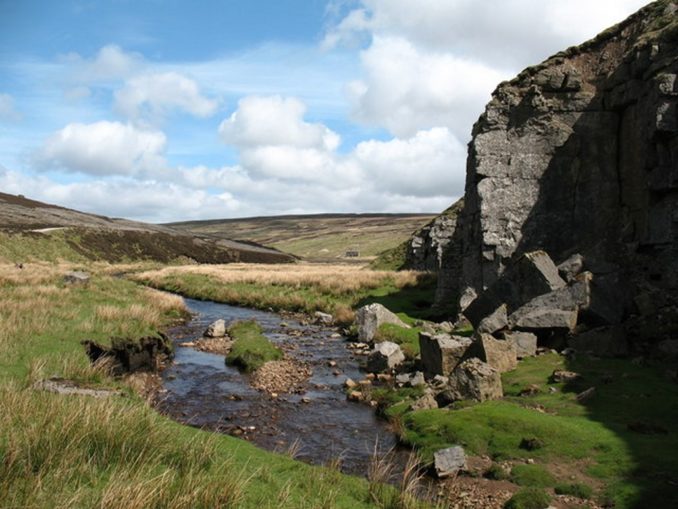
History and Early Exploration of the Mossdale Caverns
I have always been claustrophobic. Well, that’s not strictly true. I became claustrophobic when my brother locked me inside a cupboard when I was four. Why did he do that? Probably because a thirteen-year-old boy resents the arrival of a much younger sibling and finding out he is no longer the centre of his Mummy’s attention. More probably because he was a bastard.
Most people have a tendency towards claustrophobia, but what is discomfort, becomes terror for me personally when you add the dimension of water within an enclosed space. In my past life I have had to do things that I didn’t really enjoy, but in order to do A first you will have to do B and C. A case in point is underwater escape training, or as they were colloquially known: “dunker drills.” A means to an end for those who regularly operate in helicopters over water. Four escapes from a submerged helicopter, the last one being a simulated crash into the sea, at night and the cab rolls over to simulate the weight of the rotor head inverting the helicopter. Now if you lost your way and ended up under the seats, looking for the escape window, the Navy diver would have chuckled to himself contemptuously, dragged you out, and your colleagues would have been mightily pissed off with you, because everybody would have to do it again until you and everybody else got it right. It was the classic military tactic of inducement through your comrades’ expectations. No pressure.
Interestingly, the only people who got out of the Sea King that crashed into the sea during the Falklands War, had completed underwater escape training and the lesson was learned as well as identified. I have done some pretty bone things during my life, past or otherwise, but you would never get me anywhere near a water-filled cave system. However, I have the utmost respect for people who explore these hidden wildernesses. They are simply far braver that I am.
Mossdale Caverns is a cave system in the Yorkshire Dales, England. It is 3.1 miles north of Grassington, and east of Conistone, where Mossdale Beck sinks at the base of Mossdale Scar. It lies at an altitude of 1,394 feett on the eastern flank of Wharfedale, and extends south-east beneath Grassington Moor. It is an extremely lonely and remote place. Two men are credited with the discovery and exploration of the Caverns, Eli Simpson and Bob Leakey. In the 1930s Simpson, a founder member of the British Speleological Association, gathered together a large number of early geological records and old mine plans covering the area between Hebden Gill and north towards Bycliffe Hill. His interest in these documents was driven by his belief that the answer to the last major unsolved speleological problem of the Yorkshire Dales; the Mossdale Beck Grassington Moor- Black Keld resurgence, could be found in the abandoned lead mines of Grassington Moor. He was convinced that the longest and deepest cave system in the British Isles lay beneath the Moor.
About this time Simpson enlisted Bob Leakey to aid him in his search. Leakey was an aeronautical engineer and together they began to systematically explore the mine shafts and accessible levels that lie between Yarnbury and further away across the moor to Peru and Turf Pits Mines. For completeness, they explored and surveyed all the drainage levels that poured into Hebden Gill. Once more this method produced no results and finally Simpson turned his attention to the large stream that disappeared at the base of Mossdale Scar.
In late April 1941, Bob Leakey began his search for a way into the caverns he believed lay beyond the jumble of fallen boulders at the foot of Mossdale Scar. Leakey lacking the support of fit young males, enlisted the help of hardy and fit young women from the aircraft factory. On 31st May 1941 Leakey was searching for his pipe (naturally), which had dropped out of his mouth into a collection of boulders beneath Mossdale Scar and found his way into a stream passage. After a short distance he dropped down into a narrow fissure into a pool of water (sump) that he had to duck under to make further progress. He called this entrance “The Lavatory Basin.”
Leakey and his team of women were joined by Lewis Railton and in a few months they had explored about four miles of cave passaged beneath Grassington Moor. It took many arduous trips into the cave system, most lasting several hours, to complete the survey of the caves. Many of the trips into the system were completed by Leakey operating on his own and he would sometimes sleep in dryer parts of the caverns to avoid having to go back to the surface. In the weeks that followed the three girls in his party were induced to brave the horrors of the Basin. The party explored as far as Assembly Hall, a large flat-roofed cavern where they met the beck, then downstream to a wide pool of peaty water. Bob plunged through the sump and by kicking out boulders and gravel holding back the water, managed to create an airspace all the way through. The ladies were tied onto a length of rope and pulled through. More river cave led to the second Drown or Glory, dealt with in a similar way.
The explorers found a magnificent stretch of river cave leading to three more intricate ways forward which joined at Rough Chamber where the main stream passage seemed to end. Tucked away behind a sill of rock was the way on, a hands and knees crawl which quickly earned the name of Rough Passage. On a later trip Bob, Ken, and others pushed on past Kneewrecker Junction, 600 feet from the start of Rough Passage. Jean Wright, one of Bob’s climbing companions was sent down the then unexplored Near Marathon Passage. Bob’s party returned from the mighty caverns of Kneewrecker Series to find no sign of Jean. Setting off down the crawl Bob found her well down Near Marathon, stuck. After a great deal of manoeuvring, he managed to pass her and help her turn round. Then the long crawl out began, with Jean’s lower attire somewhat lacking. Around this time a ‘New Entrance’ was discovered, which meant the Caverns could be entered through a dry passage rather than having to crawl through ‘The Lavatory Basin.’

© CaveMaps.org CC BY 2.0 UK
But despite the excitement of the exploration of the caverns, Bob Leakey knew that this underground labyrinth could be a dangerous place. The proximity of the large stream disappearing into Mossdale Scar and the high water marks in the chambers and tunnels, indicated that this was no place to be when heavy rain fell on the moor. It is a very flood-prone challenging cave system, with many of its passages involving long wet crawls. Other sections have neck-deep water and many of Leakey’s explorations were conducted solo as few of his contemporaries had the necessary endurance. The end was finally reached again in 1964 by Mike Boon and Pete Livesey. A return trip to the far end takes between eight and ten hours.
The last two years of the 1950s saw a number of demanding cave rescues in the Yorkshire Dales, particularly in the Dow Cave Providence Pot system. These rescues required large reserves of manpower, pushing the Cave Rescue Organisation (CRO) and The Upper Wharfedale Fell Rescue Association (UWFRA) close to their limits. As a result, the CRO decided to establish local cave rescue teams sourced from the areas where the major caving clubs were based i.e. Leeds and Bradford and some of the small towns in Lancashire.
On July 25th, 1953 two members of the newly formed Ilkley Pothole Club, Ted Ackroyd and Eric Woodrup entered Mossdale Caverns, the time was 10.00. When they hadn’t returned to the surface by 22.00 that evening their companion, who had remained on the surface raised the alarm and the Upper Wharfedale Fell Rescue team were alerted and set out for the cave.
The two men spent most of their time underground that day exploring the Far Western Passages of the system; on their return to the entrance, upon reaching the main stream passage, they noticed that the water level has risen considerably. With great difficulty, they managed to make their way to Assembly Hall, a large flat-roofed chamber quite near to the entrance. Once there, due to the volume and force of the water they made a decision to remain in Assembly Hall until the water level had dropped sufficiently to allow a safe exit.
The two men had come well prepared and upon checking their resources found that between them they had: Two headlamps and batteries, one hand torch, seven-part candles, one waterproof tube of matches, six spare bulbs, one petrol lighter, four wet cigarettes and a piece of chalk. They decided to move as high in the chamber as possible to keep clear of the rising water. From this position they lit a candle and with this, they dried out the wicks of the remaining candles. After establishing what they thought was a more comfortable place to wait, the pair discussed the options available to them. They devised a plan to keep warm by frequent exercise and to explore that part of Assembly Hall above the main stream.
After a time the water level in the stream appeared to drop and they briefly discussed the possibility of trying to reach the entrance. Once more shortly after this, the water rose again and on this occasion came a foot higher than it had previously. During the night, the level of the stream dropped slowly, until finally, in the early hours of the morning, they heard the shouts of the rescue team. Through their shouts and flashing lights they guided the team to where they were at the top end of Assembly Hall. The team provided them with dry clothes; they were given a pot of tea and a bar of chocolate as sustenance. The two cavers left the cave at 0315 hours on the Sunday morning, seventeen and a half hours after entering it. Despite the successful outcome of this rescue, the team realised that if the rainy weather at the time of this incident had not improved, the outcome could have been very different.
Seven years later on 20th June 1960 the UWFRA was called out to Mossdale Caverns again, when a party from the University of Leeds Speleological Association (ULSA) entered the system to carry out a survey of the far reaches. Two of the party, June Willbank and John Stevens became separated and the rest of the team were unable to locate them. They were weary after a day spent surveying the caverns and decided to leave the caves to raise the alarm.
At 04:30 a large team from the UWFRA assembled at the cave entrance and began an underground search after establishing a telephone link to the Assembly Hall. Later that morning they were joined by a rescue team from the RAF, the two missing cavers were found and were out of the caves by 10:30. The UWFRA was confident that it had proved the feasibility of cave rescues after two successful rescues but the team’s members would face their greatest challenge seven years later.
Melvin, M. (). The Mossdale Caverns Tragedy 1967. Available: http://www.michaelmelvin.co.uk/hwcpc/mossdale/index.html. Last accessed 1 Sep 2019.
Wikipedia. (). MOSSDALE CAVERNS . Available: https://en.wikipedia.org/wiki/Mossdale_Caverns. Last accessed 1 Sep 2019.
© Blown Periphery 2019
The Goodnight Vienna Audio file
Audio Player



